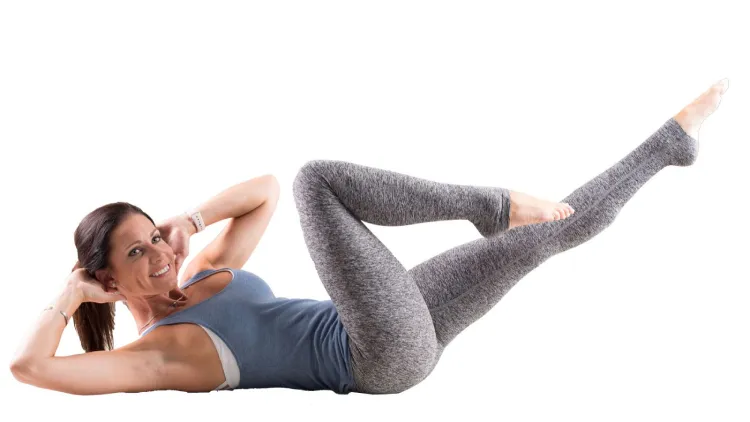Are you scouting the net in search of an easy, and effective stretch to combat the tightness in hips, lower back pain, or sciatic nerve-related pain? Then the knee to opposite shoulder stretch can be a perfect solution to your problem. This is a specific stretch that can usually be prescribed by physical therapists and fitness professionals and works by gently pulling either knee across the body and to the opposite shoulder, which can serve to relieve the muscles of the piriformis and glutes, two locations often causing the stiffness in the hips, as well as giving one the symptoms of sciatica.
The knee to opposite shoulder stretch can help in several ways: it increases hip mobility, relieves lower back pain, helps keep a better posture, as well as helps muscles recover. It is the best thing ever, not to mention that it does not require any equipment, it is beginner-friendly friendly and you can easily adapt it to your needs, based on your flexibility or mobility.
In this detailed tutorial, we are going to find out what is the knee to opposite shoulder stretch, how it is performed correctly, its health advantages, variations worth making, conditions when it should be avoided, the pointers to its efficiency, and the answers to commonly asked questions so that you have all the necessary information to support the introduction of this stretch to your daily fitness and wellness practice. This stretch is related to knee-to-chest stretch.
What is the Knee to Opposite Shoulder Stretch?
Knee to opposite shoulder is a passive stretch that is mostly done when one is lying on his back. It entails the movement of one of the flexed knees across the body towards the other shoulder to produce a diagonal pull across glutes and hip area. The piriformis muscle, which is located deep in the gluteal region and tends to cause compression of the sciatic nerve, is the focus of this motion.
The stretch is best suited in relieving the tightness of the piriformis and associated muscles, which are therapeutic and preventative in improving hip and back health.

Benefits of the Knee to Opposite Shoulder Stretch
1. Alleviates Sciatic Nerve Pain
Among the greatest values of the knee to opposite shoulder stretch is that it substitutes the pressure on the sciatic nerve. There is a possibility that sciatica, which is caused by pain that begins in the lower back and runs through the hips and along the leg side, is actually caused by a tight piriformis muscle. This allows the nerve to be freer with fewer pain points accompanied by enhanced comfort since the area is stretched.
2. Enhances Hip Flexibility
Strained hip muscles may interfere with your gait position, posture, and flexibility. The knee opposite shoulder stretch loosens the hip joint by stretching the tendons and muscles around the hip joint lengthily. With this hip mobility, there is enhanced freedom of movement both in everyday life and sports.
3. Reduces Lower Back Tension
Hips are directly related to the lumbar spine. Pull of lower spine by tightening of piriformis or glute can be painful. The knee to opposite shoulder stretch should be practised to eliminate the tension that accumulates in the lower back of those persons who sit down all that time.
4. Promotes Circulation and Recovery
Stretching improves the circulation of blood to the muscles involved. As you do the knee to opposite shoulder stretch, you promote more oxygen and nutrient delivery to tense or overworked locations, and this helps recover after a workout or activity.
5. Improves Posture and Alignment
Poor posture and balance may be a result of unbalanced muscles. By restoring balances in muscle length and tone on either side of the pelvis, knee to opposite shoulder stretch breaks the postural strain and makes it easier to stand, sit, and move.

How to Do the Knee to Opposite Shoulder Stretch
Stretching the knee and opposite shoulder does not need any equipment, and a flat ground is enough to execute it in less than five minutes. To do it properly, follow the steps below:
Step 1: The Lie-Down technique
The first way begins by lying down flat on your back with the legs straight and arms hanging at your side. Ensure that you are on a cushioning surface such as a yoga mat or rubberised floor.
Step 2: Bending One Knee
Bend your right knee and bring it gently to the chest with the left leg straight on the floor.
Step 3:Bring Knee to Other Side Shoulder
With both hands behind you, reach over and grab your right knee and pull it (making a diagonal) towards your left shoulder. The movement has to be slow and deliberate.
You must experience a stretch on the right glute and hip. Make sure your lower back is down on the floor and do not turn your torso.
Step 4: Holding a Position
Stretch and breathe deeply into it, holding the stretch 20 to 30 seconds. Calm on and allow the muscles to give up.
Step 5: Turn sides
Gradually straighten your right leg and bring it back to the position of zero. Do the same on the other leg.
Do 2-3 sets of it on each side with the level of your comfort.
Tips for Best Results
To make the most of the knee to opposite shoulder stretch, it may take into consideration the following suggestions:
- Prevents stretching before warm up. 5 minutes prepares the muscles with gentle walking, or dynamic movements.
- Employ a support such as a pillow under the head or a folded towel under the hips, if you want to feel more comfortable.
- Don’t be overstretching. From time to time, be slow, and if sharp or strong pain, from slightly.
- Consistency is number one. Following this stretch regularly, 4-5 times a week, will improve your flexibility and relieve you.
- Aquina control on breathing. Deep, steady breathing also causes your body to relax into the stretch.

Variations of the Knee to Opposite Shoulder Stretch
To modify the exercise to adapt knee to opposite shoulder stretch to your level or personal preferences, then the following variations can be attempted:
1. Seated Knee to opposite shoulder stretch
Can you not be in a lying-down position? There is one sitting:
- Also sit down on a chair with both feet flat on the ground.
- You should cross your left knee with your right ankle.
- Softly drag your right leg body across towards your left shoulder.
- 20 30sec lift and change side.
This discrepancy is not good at all for those working in offices or the elderly who have issues related to mobility.
2. Resistant Band Assist
Stick a resistance band or a yoga strap on the foot of the stretchable leg. This allows you to regulate the depth of the stretch more gradually, and this is convenient when you are a person with tight hips and decreased flexibility.
3. Lying variation Twist
When in the hold of the stretch, you can roll your torso in the other direction to perform a spinal twist. This further stretches to hit more muscles on the spine and lower back.
When Should You Avoid This Stretch?
Generally, the knee to opposite shoulder stretch suits most individuals despite this activity being risky under some conditions:
- Hip, spine or knee surgery (in the last few years)
- Severe acute sciatica and pain/numbness
- Bulging (condition) or Herniated discs
- Pregnancy(use a professional first)
So, just in case you are not sure that such a stretch is safe to take, consult a physical therapist or some other medical professional before doing it.

Final Thoughts
The lower-back-relieving stretch that extends to the shoulder is quite simple yet strongly advantageous to promote the health of the hip, lower back, and nerve pressure. It can be accessible to almost anyone since it does not require any special equipment, and the time it may take a person to execute the activities is minimal.
Knee to opposite shoulder stretch is an easy and safe way to alleviate the effects of sitting all day long or merely an attempt to become more mobile. Do it every day, listen to your needs and enjoy the results of higher flexibility and pain relief.
Frequently Asked Questions
1. I want to know how frequently I should perform knee to opposite shoulder stretch.
Knee to opposite shoulder stretch can be performed once a day or twice every week. To relieve long-term tightness or pains in the sciatic nerve, it is recommended to do 2- 3 sets on each leg each day.
2. Do you think this stretch can assist with sciatic nerve pain?
Yes, this is one of the best recommended stretches in relieving symptoms of sciatica caused by tight piriformis. It alleviates nerve compression and increases motion.
3. Is it alright that during the stretch, one feels a little discomfort?
Mall pulling or force is harmonious, but severe or jerking understanding is not. It must always be at a comfortable regular range of motion and must not be pressured.
4. Is the knee to opposite shoulder stretch suitable for beginners?
Absolutely! This is an intermediate stretch which is simple to alter. You will be able to apply props or to shorten the range of motion accordingly.








4 thoughts on “Knee to Opposite Shoulder: 5 Great Benefits & Ultimate Tips”
An impressive share, I just given this onto a colleague who was doing slightly evaluation on this. And he in truth bought me breakfast as a result of I found it for him.. smile. So let me reword that: Thnx for the treat! But yeah Thnkx for spending the time to debate this, I really feel strongly about it and love studying more on this topic. If potential, as you become experience, would you mind updating your blog with extra particulars? It is highly useful for me. Big thumb up for this blog publish!
Thank you so much! I’m glad you found it helpful and enjoyed the discussion. I’ll definitely keep sharing more updates soon!
Wow! This blog looks just like my old one! It’s on a completely different topic but it has pretty much the same layout and design. Superb choice of colors!
Thank you so much! Great to hear it brings back good memories. 😊